
Search Wild Foods Home Garden & Nature's Restaurant Websites:
Canadian Bunchberry
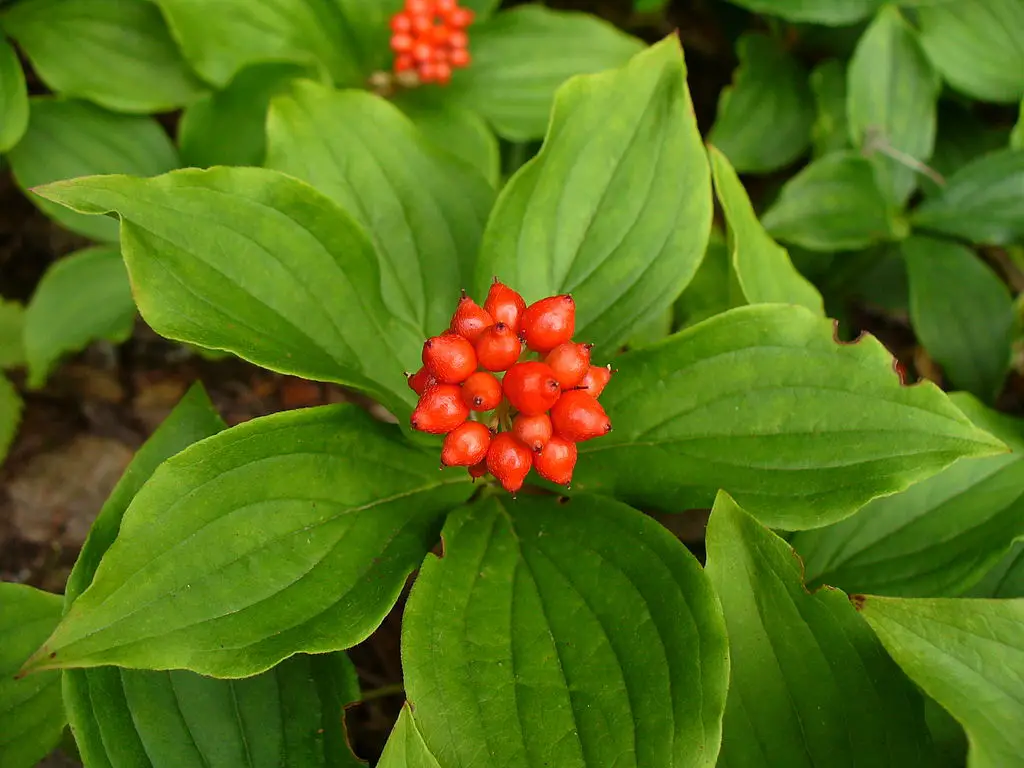
Canadian Bunchberry. (By: Neelix.)
(NOTE: If you are not interested in growing the Canadian Bunchberry, but just finding the fruit and using it, try going to the Nature's Restaurant Online site for Canadian Bunchberry .)
Canadian Bunchberry (Cornus canadensis). Also known as the Creeping Dogwood. This is the smallest of the Dogwood (Cornus) genus. It acts like a ground-cover plant, carpeting areas growing about 15cm (6 inches) tall on average. This is one of those plants that forms what are known as clonal colonies, that is, all the plants in one area are all from the same roots (rhizomes in this case) with plants sprouting up from them, all genetically the same plant even though above ground they look like a group of individual plants.
Is the growing of this plant compatible with Natural farming, Ecoagriculture or Eco friendly agriculture, Ecological farming, Sustainable agriculture, Agroforestry or Agro-sylviculture and Permaculture: Natural farming, no-till gardening is the only way to grow this plant. Once established, you need never disturb the soil.
Soil & Site: If you have the right habitat of cool, shaded, moist area with acidic soil that has a lot of organic matter this might be a nice plant to grow. There are not a lot of plants that like the conditions this likes to grow in that will fully cover the ground and provide food.
Seeds: I don't know about starting from seed, but in general, plants that spread from the rhizomes tend to transplant well and be difficult to impossible to start from seed.
Transplanting: Dig up a few plants from a colony, put in a wide flat, container (like a kitty litter box), take home and plant. I would suggest keeping it wet for the first year. Do it in the fall after the leaves have turned red and the plant is dormant. Put down some peat moss, or bark mulch over the area after you plant it in the new spot.
Maintenance: If you put this plant in a cool, shaded moist area with acidic, organic rich soil there is nothing to do once it takes. If the spot you put it does not stay moist on its own, you need to help it stay damp.
Harvesting: The clusters of red berries on the top of the plant are ready for harvesting in late summer to early fall.
Using: I suggest not eating the berries raw - they can cause the skin to become itchy where the raw berry touches. That said, many people do eat them raw - I just suggest not. They can be good to nothing tasting - the taste is always very mild. Sometimes a little apple like, sometimes, almost no flavor at all. Best for adding to other jams and jellies: cook with some water, separate the pits (food mill or sieve), then add to the other jams & jellies. They will help the other fruit gel (Bunchberries have high natural pectin levels). It works as well as store bought pectin, and the flavor is so gentle, the other fruit's flavors will stay the same. Best to think of them as a natural ingredient (pectin) as opposed to a flavor themselves, and you will not be disappointed.
Identification: The leaves have the Dogwood leaf look (because it is a Dogwood), in that the veins all sweep toward the tip of the leaf. There are six leaves, two larger ones, four smaller ones. Sometimes however, the bigger two are not that much bigger than the other four, so it looks like there are six leaves pretty much the same size. All six leaves come from the plant in the same spot, giving a whorl (circle) of six leaves. If you look very closely at how the leaves attach to the stem of the plant, you will notice the two bigger leaves attached to the stem in an opposite pair, and on each side where the two attach, there is a leaf on each side coming out.
Description:
- USDA Plant Hardiness Zone: 2-7 (More information on hardiness zones).
- Soil pH: 5.5-6.9 (ideal range: 6.0-6.5)
- Plant Size: up to 20 cm (8 inches) tall
- Duration: Perennial small Shrub (a Subshrub)
- Leaf Shape: Ovate
- Leaf Phyllotaxis (Arrangement) on branch: Opposite, but appear to be a whorl of six leaves. However, there are actually two opposite leaf nodes that have three leaves coming from each node - the slightly to moderately bigger central leaf, and the smaller side leaves
- Leaf Size: 2.5 to 9cm long (1 to 3 1/2 inches) and 1.5 to 5cm (5/8 to 2 inches) wide
- Leaf Margin: Entire (smooth edged)
- Leaf Notes: Color is green to yellow-green hue, in the fall they turn red (dark purplish red) first in the veins, then the whole leaf. Leaf veins are obvious and typical for a Dogwood - that is, the veins sweep toward the tip of the leaf
- Flowers: When you first look at the flower, what you think you see is a single white (starts out green) four petalled flower with a tiny flower cluster in the center. The four outer "petals" are actually bracts, while the real flower is the little flower cluster in the center of the white bracts. That is where the berries will form.
- Fruit: The berries (actually drupes) start out as green, and turn a bright red to orange hued red in July to August. The have one or two oval shaped stones. Each drupe is about 5mm (little under 1/4 inch)
- Habitat: Cool, moist, shaded conifer, deciduous, and mixed woods. Tolerant of varying acidity levels. Likes areas of deep organic soils, peaty soils and decaying wood. More likely to find this small shrub where the soil stays moist all year, like close to bogs and wet areas.
Web Resources:
- Recipe search on the web here (Google search) and here (Bing search).
- Pictures on the web here (Google images) and here (Bing images).
- Interactive USDA distribution map and plant profile here.
- The Biota of North America Program (BONAP) distribution map here. BONAP map color key here.
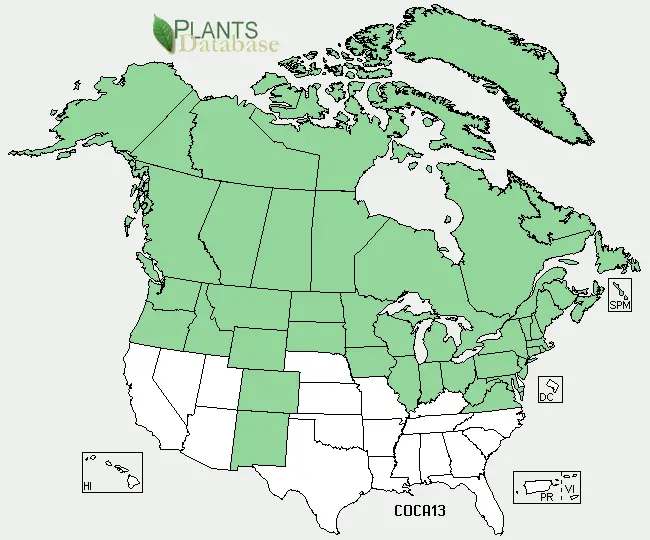
Canadian Bunchberry (Cornus canadensis) range. Distribution map courtesy of U. S. Department of Agriculture (USDA Natural Resources Service) and used in accordance with their policies.
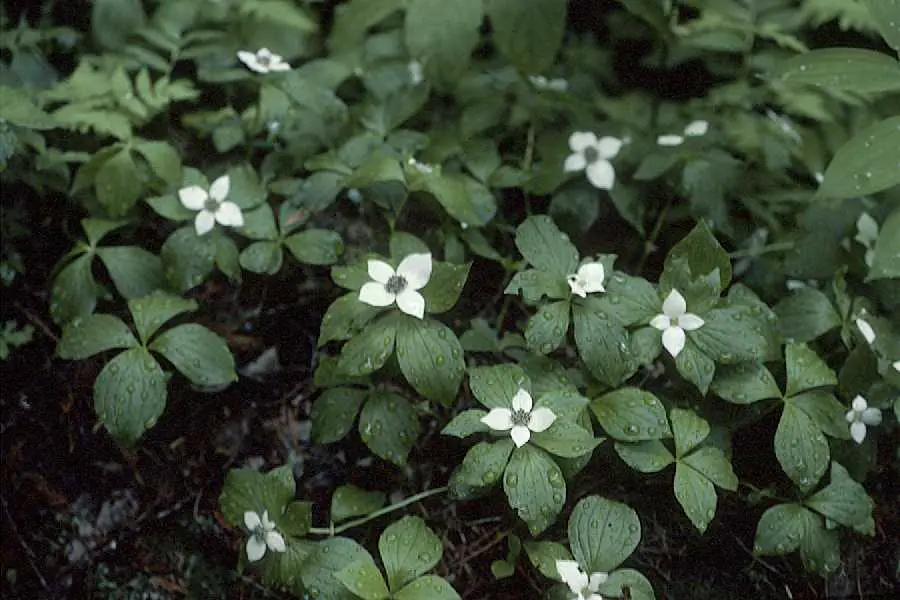
Canadian Bunchberry in flower before the berries. (Robert H. Mohlenbrock, hosted by the USDA-NRCS PLANTS Database / USDA NRCS. 1995. Northeast wetland flora: Field office guide to plant species. Northeast National Technical Center, Chester.)
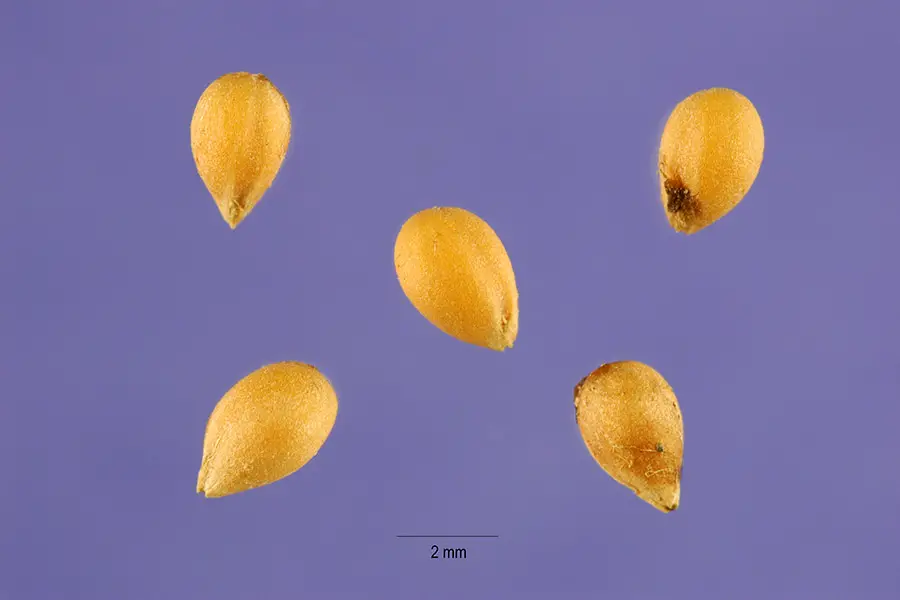
Canadian Bunchberry (Cornus canadensis) seeds. (Steve Hurst, hosted by the USDA-NRCS PLANTS Database)
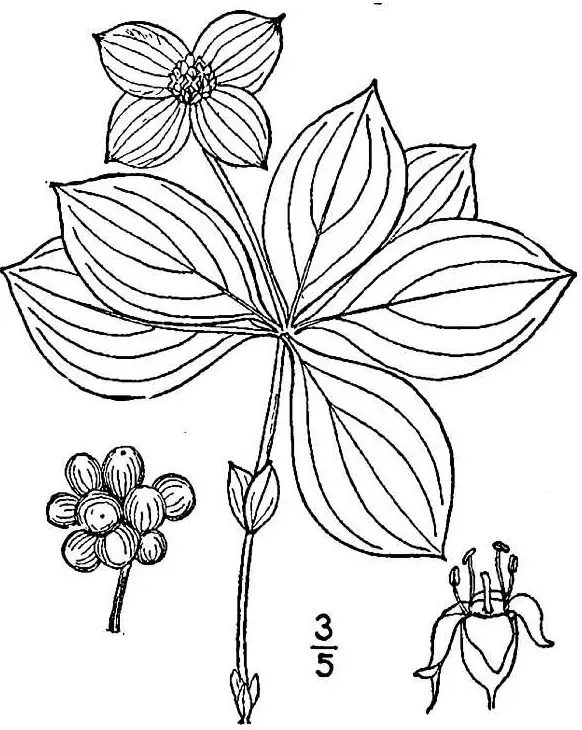
Drawing. (USDA-NRCS PLANTS Database / Britton, N.L., and A. Brown. 1913. An illustrated flora of the northern United States, Canada and the British Possessions. 3 vols. Charles Scribner's Sons, New York. Vol. 2: 664.)
Search Wild Foods Home Garden & Nature's Restaurant Websites:
Share:
Why does this site have ads?
Originally the content in this site was a book that was sold through Amazon worldwide. However, I wanted the information to available to everyone free of charge, so I made this website. The ads on the site help cover the cost of maintaining the site and keeping it available.
Google + profile
